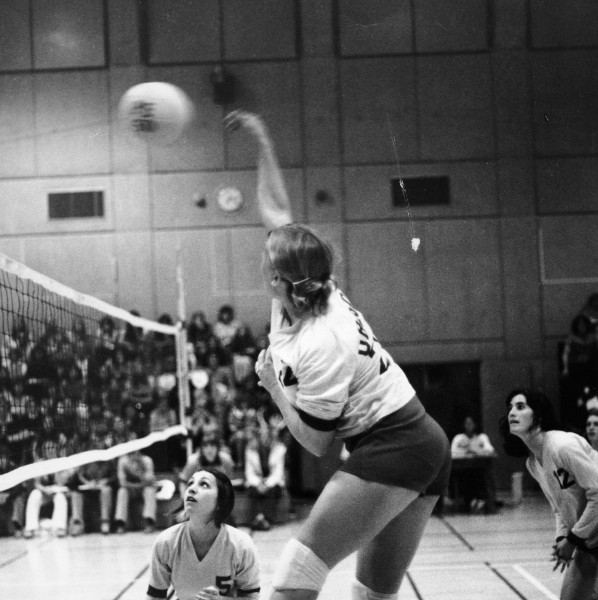Amping Up the Options
 Basketball and field hockey served as early staples for women’s intercollegiate athletics at Oregon. However, it wasn’t until the late 1960s that the University began making a concerted effort, though modest at the time, to support a wider range of women’s teams. Resembling more of the club sport structure, the University volleyball team established footing in 1967. The basketball, softball, and track and field teams also gained momentum during this period. Within the next decade, women’s golf (1972) and cross-country (1974) were added to the slate, and by 1977, Oregon offered ten intercollegiate sports for women: basketball, cross-country, field hockey, golf, gymnastics, softball, swimming and diving, tennis, track and field, and volleyball.
Basketball and field hockey served as early staples for women’s intercollegiate athletics at Oregon. However, it wasn’t until the late 1960s that the University began making a concerted effort, though modest at the time, to support a wider range of women’s teams. Resembling more of the club sport structure, the University volleyball team established footing in 1967. The basketball, softball, and track and field teams also gained momentum during this period. Within the next decade, women’s golf (1972) and cross-country (1974) were added to the slate, and by 1977, Oregon offered ten intercollegiate sports for women: basketball, cross-country, field hockey, golf, gymnastics, softball, swimming and diving, tennis, track and field, and volleyball.
During the 1970s, opportunities abounded for women, even though funding barely kept the teams in uniforms. With new sports came the integration of more substantial coaching staffs, including the addition of full-time head coaches. In 1977, Tom Heinonen became the full-time cross-country and track and field coach and Elwin Heiny assumed the head role for the basketball squad.
Despite the addition of new sports and coaches, a major crisis struck the Athletic Department in the early 1980s. Having committed more than $1 million per year in efforts to reach Title IX compliance statutes, the University was operating with a deficit. As Rick Bay assumed the role as Athletic Director in 1981, the department made the decision to eliminate four sports from the intercollegiate offerings: men’s baseball, men’s gymnastics, women’s golf, and women’s soccer.
In 1986, golf was reinstated and ten years later, women’s soccer reappeared, both in efforts to bring the University closer to compliance with Title IX. Lacrosse, the most recent addition to Oregon’s sports offerings, officially kicked of its first season in 2005. As the first Northwest school to offer the sport, Oregon felt the growing interest in lacrosse would be an ideal fit for the school. Also, since there was already a soccer field in place, the costs of building a lacrosse program would be less than integrating a sport that required a new facility. Oregon has sponsored a club team since 1995.
By 2005, Oregon offered nine intercollegiate athletic teams for women: basketball, cross-country, golf, lacrosse, soccer, softball, tennis, track and field, and volleyball. As the University continues to expand its intercollegiate program, the possibility of adding more women’s sports, as well as men’s, hinges on financial support. As one of only 17 fully functional, self-supported programs in the nation, U of O Athletics must balance the budget with equal opportunities for both genders. The recent trends of full-time coaching staffs, additional athletic support services, and top-notch facilities weigh heavily on any decisions. Regardless, women’s athletics have gained a strong foothold for the future.